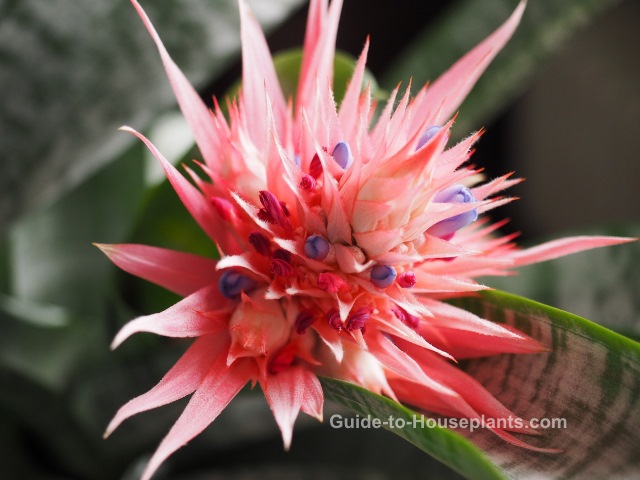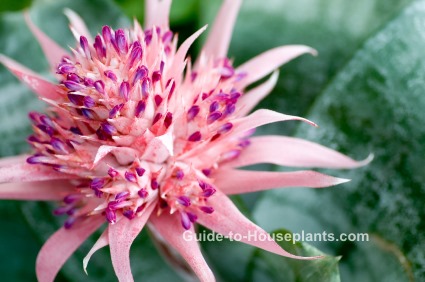Urn Plant
Botanical Name: Aechmea fasciata
Urn plant is an exotic-looking flowering plant from the bromeliad (Bromeliaceae) family.
Aechmea fasciata grows in a rosette of stiff, arching leaves that form an urn. In its native South American rain forest, the leaves gather rain water in its urn, which must be filled with water at all times. Brown leaf tips are a sign that the plant is too dry.
 Bring a fresh splash of tropical color to your home with easy-care Aechmea fasciata.
Bring a fresh splash of tropical color to your home with easy-care Aechmea fasciata.Despite its exotic appearance and tropical nature, this bromeliad adapts well to living as a potted house plant.
Urn plants are often bought at garden centers or florist's shops already in bloom. They have shallow root systems and won't need repotted.
Want to hide a plain nursery pot? Slip it into a cachepot -- a decorative container without drainage holes. I put small rocks in the bottom of my cachepots to hold plants above the drainage water. As the water evaporates, it adds humidity around the plant.

In mature plants (3 years old), the mottled, silvery green foliage is upstaged by a crown of long-lasting pink bracts. Between the bracts, small violet flowers appear that quickly turn red. The flowers themselves are short-lived, but the bracts last for a few months.
Got a late bloomer? Plants that don't produce bracts aren't getting enough light. Move your plant to brighter location.
Still won't bloom? If it still won't produce a flower stem, you can encourage it to bloom with this easy trick: Place a ripe apple or a few apple cores around the plant and enclose the whole thing in a clear plastic bag for a week or two. The apple gives off ethylene gas that promotes blooming. Keep your plant out of direct sun while it's covered with the plastic bag to prevent it from getting too hot.

Like other bromeliads, urn plant only blooms once then dies. Allow the plant to die back naturally. After flowering, you can expect each plant to produce 2-3 pups. Remove them when they are about 5 months old and at least 6 in (15 cm) tall and pot them in their own containers.
Propagating its offsets that grow at the base of the plant will allow you to enjoy these beautiful bromeliads for years to come.
You may find Urn Plant sold by other common names: Silver Vase Plant or Vase Plant, or by its botanical name, Aechmea fasciata. Some striking varieties are available, such as 'Variegata' with creamy yellow stripes on its leaves. 'Purpurea' has silvery leaves blushed with maroon.
Urn Plant Care Tips

Origin: Brazil
Height: Up to 20 in (50 cm)
Light: Bright light with some direct sun. With this bromeliad plant, care should be taken to move plant to direct sun gradually to avoid scorching its leaves. A few hours of morning sun is ideal.
Water: Keep the plant's urn filled with water at all times and change it weekly. Water regularly to keep the soil lightly moist, but not soggy. Don't allow the urn to dry out for very long. Brown, shriveled leaf tips are likely caused because the plant is dry.
Humidity: Try to maintain a relative humidity around 50%. Take a look at these easy ways to raise humidity for houseplants.
Temperature: Average room temperatures 65-75°F/18-24°C
Soil: Orchid potting mix or mix equal parts: fir bark, peat moss and sharp sand or perlite.
Fertilizer: Feed monthly spring through summer with a balanced liquid fertilizer diluted by half in the plant's urn, then empty it after 1 week and fill with water. Or mist the leaves with a weak foliar fertilizer once a month.
Propagation: Cut off the offsets -- called pups -- when they are at least 6 inches tall and plant them in fresh, barely moist potting mix.


